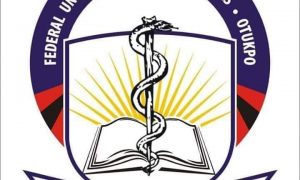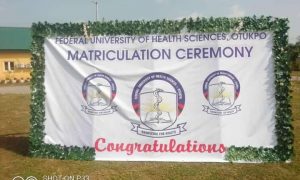(OPINION) Let’s save University Of Medical Sciences, Akpete-Akpa
By Nats Onoja Agbo
In the dying days of the last administration in Nigeria, the College of Health Sciences, University of Agriculture, Makurdi, which was located at Akpete-Akpa in Otukpo Local Government Area of Benue State was upgraded to a Federal University of Health Sciences.
The establishment of that university made it the first of its kind in Nigeria; it was also in response to the growing need for medical institutions in Nigeria. There are university-based medical colleges in Nigeria, no doubt, but the trend in most parts of the world is a gradual movement towards the establishment of Universities of Health Sciences.
The Indian example is worth mentioning because that country attracts more than 18, 000 Nigerian medical tourists every year. India has 381 recognized medical colleges and 44 medical universities that are recognized by the Medical Council of India. The medical universities train doctors and other allied health professionals. Sixteen out of the 80 top universities in India are medical Universities. The health care industry in India earns revenues accounting for 5.2 percent of Gross Domestic Product (GDP) and employs as many as 4 million people. According to reliable sources, India’s earnings from the health sector could reach $73 billion by 2020.
A report that was published in Leadership, one of Nigeria’s leading newspapers, November 21, 2015 shows that Nigeria loses three billion naira to medical tourism annually. Nigeria alone accounts for 42.4 percent of the medical tourism list of Africans going to India for medical attention. The Indian High Commissioner in Nigeria was recently quoted as saying that Indian hospitals received 18,000 Nigerians on medical visa in 2012 and about 15,000 in 2013. In monetary terms, Nigerians spend about $260 million annually in search of medical attention in India. India’s pharmaceutical exports to Africa equally increased from $247.64 million in 2000 to $3.5billion in 2014.
Other countries that have shown tremendous interest in the establishment of medical universities are Bangladesh, Pakistan, Austria, Ukraine, Libya, South Africa, Ghana, Uganda, Gambia, Kenya and Iran. Bangladesh converted its Bangladesh Institute of Health Sciences into a University of Health Sciences and the university has attracted grants from other organizations including the University of Oslo in Norway, Rockefeller Foundation in the US and the World Diabetes Foundation, which is based in Denmark for various academic and development projects.
One of the most notable medical institutions in Pakistan is the University of Health Sciences, Lahore in the Province of Punjab. With about 60, 000 registered students and 72 affiliated institutes and colleges, the University of Health Sciences, Lahore is indeed the largest medical university in Pakistan. Austria has four medical universities just as Ukraine has 14 medical universities. Libya has only one privately-owned medical university, the Libyan International Medical University, just as South Africa established the Sefako Makgatho Health Sciences University in 2014.
The Ghana example is even unique. With a population of twenty seven million people, that country has nine public universities including the University of Health and Allied Sciences established in 2011. The uniqueness of the Ghanaian system is that its Universities are established on the concept of unique specialization. Apart from the first three early general universities (University of Ghana, 1948, Kwame Nkrumah University of Science and Technology 1952 and University of Cape Coast, 1961), the other public universities are uniquely defined (University of Education 1992, University for Development Studies, 1992, University of Professional Studies 1965, University of Mines and Technology, 2001, University of Health and Allied Sciences, 2011; and University of Energy and Natural Resources, 2012).
Uganda has eight recognized medical schools and an International Health Sciences University, which was established in 2008, just as the American International University of West Africa (University of Health Sciences), which was established in 2011 with students from 74 countries, is Gambia’s first private university. Iran has eleven medical universities while plans are afoot to establish a University of Health Sciences in Kenya.
It was therefore hoped that the Federal University of Health Sciences, Akpete-Akpa would join the league of medical universities that are consciously engaged in medical research and proffering solutions to health challenges in several parts of the world. It is therefore disheartening to learn that the Federal University of Health Sciences, Akpete-Akpa has been returned to the University of Agriculture, Makurdi as a college.
It is not easy for an outsider to fashion out the reason(s) for certain actions of government. But this writer is persuaded to believe that the reason(s) adduced for the change in status of this unique university could never outweigh the gains. Moreover, the decision does not appear to be in tandem with President Muhammadu Buhari’s resolve to re-invigorate the educational sector with progressive ideas and policies. Addressing some youths during a programme, which was tagged “Secure the Future: Discussing the Future with the Youth” in Lagos on March 13, 2015, Buhari promised to pursue policies that would empower them, saying the youth were the hope and future of the nation. He emphatically stated that functional education held the key to youth empowerment. The News Agency of Nigeria, which covered the event, quoted him as saying that no nation could develop without a functional educational system. He therefore promised to ‘evolve creative solutions to address some of the major challenges in the sector’.
President Buhari’s resolve to make functional education the focus of his educational reforms sits well with modern approach to education and national development. Indeed, the role of functional education in the development of the society cannot be over-emphasized. As noted by the Israeli, Yehuda Zeilberger, functional education takes root from the immediate environment of the individual, from the ward, to the village and would cover the individual’s daily experiences. In the US and Germany, functional education comes directly from the influence of the environment, but in Western Europe it comes from the child’s needs and uses the child’s interests as a mechanism for activating him towards his desirable activities.
The purpose is to develop the life of the mind that acts from the wholesome of organic life, with relation to practical life. Functional education is therefore a process through which an individual is transformed into a participant in the social and economic development of his immediate society. A functional educational system works in tandem with the dynamics of the labor market, and usually equips its products with the necessary skills and competences so they could be self-reliant and be in a fortified positions to contribute to the economic development of their society.
As this writer has noted elsewhere, national development is the ability of a country to improve the social well-being of its citizens through the provision of such amenities as medical care, infrastructure, quality education and other social services. A developed country can therefore be described as that country in which the citizens have access to social amenities that will improve their well-being, while a country without such amenities can be described as underdeveloped or developing.
There are some who argue that rapid quantitative expansion of educational opportunities does not guarantee equally rapid social and economic development. The indices are there: despite the increase in the number of enrollments in primary, secondary and tertiary institutions in Nigeria, most graduates of tertiary institutions are unemployed or under-employed.
But as Professor Frederick Harbison argues, “human resources…constitute the ultimate basis for the wealth of nations” because while capital and natural resources are factors of production, human beings are the active agents who accumulate the capital and exploit the natural resources. Human beings also “build social, economic and political organizations, and carry forward national development”. According to the eminent professor, “… a country which is unable to develop the skills and knowledge of its people and to utilize them effectively in the national economy will be unable to develop anything else”.
There is therefore the need for the Nigerian government to invest heavily in the educational sector and in saying this one must draw from the experiences of other countries.
When Japan adopted modern educational standards in 1872, twenty-nine years after Western education reached Nigeria, its leaders adopted four principal aims, which became the propelling forces of their educational system. Japanese education was customized to contribute to the peace and welfare of humanity, develop the full personality, create love for truth and justice among students and promote commitment to academic freedom, equal opportunity and co-education. Japan’s emphasis on the development of the full personality, which in effect meant the development of its society, has impacted positively on the country. By 1952, the country was ranked as a less developed country, LDC; by 1953, its economy took quick, giant steps that saw it growing at eight percent per annum. The growth was so much that by 1968, Japan had become the world’s second largest economy. This phenomenal growth necessitated a major shift from reliance on agriculture and light manufacturing to heavy industry and services, thus accelerating the pace of urbanization. Such feat was attained because Japan was able to effect ‘a shift in employment from low productivity, primary pursuits to manufacturing and a skilled and trained labor force with a strong commitment to work’.
The enchanting growth of the Chinese economy also exemplifies how education can accelerate social and economic growth of a country. By 1985, China was still grappling with how to create a harmonious relationship between functional education and national development. Indeed, China took deliberate steps to engage its citizens in education and production; those who did not go to formal schools became apprentices, and in the final analysis, China moved elegantly into the position of a world superpower.
Today, China is the world’s fastest growing economy. By 2013, that country became the world’s second largest economy based on the nominal Gross Domestic Product, GDP, and the purchasing power parity, PPP. More over, China became the world’s largest exporter and importer of goods. The country also became a nuclear weapons state and the country with the largest standing army in the world. Malaysia has been investing heavily in education. As a result, all Malaysian children attend primary school, and well over 50 percent attend secondary school. That country combines educational investment with health expenditures and employment creation, thus achieving one of the lowest poverty rates (26%) among all Less Developed Countries, LDC.
There is no doubt that Nigeria has made phenomenal progress in the educational sector. As for primary school enrollment, statistics provided by UNESCO show that from a minimum value of 40.84 percent in 1970, the figure stood at 84.80 in 2010. Access to secondary school education has however been sluggish, with the value for school enrollment standing at 43.83 percent in 2010. Tertiary education has enjoyed tremendous boom, especially since the Federal Government granted licenses to individuals and organizations to establish universities and polytechnics.
Today, there are 40 Federal Universities, 40 State Universities and 61 privately-owned universities in Nigeria.
Despite the increase in the number of tertiary institutions in the country, many applicants are still unable to access university education because of the few available spaces. In the 2004/2005 admission exercise, for instance, 841, 878 people applied for admission into the institutions, out of which only 122, 492 or 14. 5 percent were admitted. The figure dropped further in the 2005/2006 admission year when 76, 000 or 8.4 percent of the 916, 371 applicants were admitted. The following year, 2006/2007, 803, 472 people applied for admission but only 88, 524 or 11 percent of them were admitted, just as 107, 370 or 11.8 percent of the 911, 653 applicants during the 2007/2008 admission exercise were admitted. There was a slight improvement in the number of people that gained admission during the 2008/2009 exercise when 200, 000 or 18.9 percent of the 1,054,060 applicants were successful. It is because of the available spaces in Nigerian universities that many Nigerians are trooping into neigbouring countries to acquire university education.
There is therefore an urgent need to create more room for applicants to enjoy university education in Nigeria. It is gratifying to note that the Federal Government’s 2016 budget proposals leans heavily in favor of opening up the educational sector. Allocating N369.6 billion to the education sector, the largest in the budget, is clearly indicative of the government’s commitment to improving on the people’s access to quality education.
It is on this premise that one is compelled to appeal to President Muhammadu Buhari to reconsider his stand on the status of some of the universities established in the closing months of the immediate past government. On the surface, the cost of running the universities may appear daunting but so it is with every good thing; and university education is good for the country.
The beginning is always rough but in the final analysis, the country stands to gain from those universities because some of them are specialized institutions. From the antecedents of similar universities in other parts of the world, there is every hope that if it survives, the Federal University of Health Sciences, Akpete-Akpa, for instance, would revolutionize the health sector in Nigeria and bring to an end the endless search for medical attention in other parts of the world.
Agbo, a journalist and public affairs analyst, wrote from Lagos. He can be reached on onojagbo@yahoo.com























